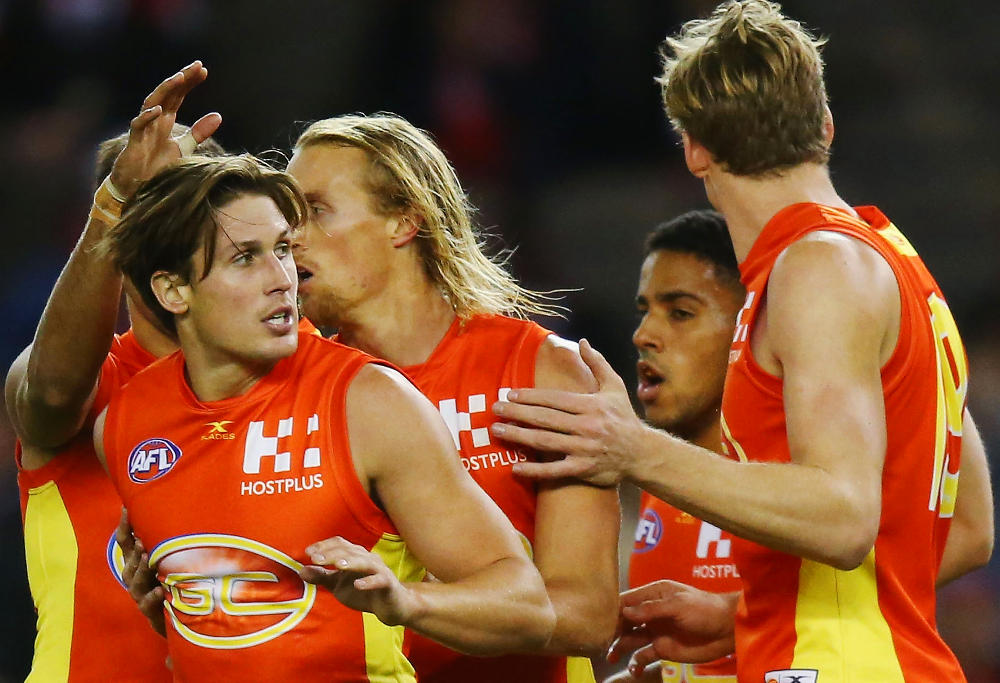Adam Ritchie
new author
Roar Rookie

Sometimes you become acutely aware that something you are doing is objectively odd.
Once I went through the checkout at Woollies with several blocks of chocolate and potato chips and little else. The cashier looked upon my haul and remarked I must’ve been having a party. I laughed in agreement.
I was not having a party.
I’ve had a similar feeling over the past few weeks as I wondered when it was safe to start talking about the football again, and by ‘safe’ I mean socially acceptable to people who don’t devote a single second of their time to wondering when it is safe to talk about football again.
Pondering this is odd. Perhaps I was tired of contemplating this when I arbitrarily decided there was no better time than now. The annual AFL trade period hope-a-palooza has long passed and the AFLW season remains weeks away. Why not smack bang in the middle of the turgid AFL offseason?
Armed with my flimsy justification and acute footballing withdrawal, I thought I would spend some of the holiday season trying to decipher what exactly football is.
Now I’m no David King. I possess no stats lab. I’ve not calculated a premiership trapezoid for you. But I have attempted to distil Aussie Rules football into a very basic idea – one I hope will prove insightful, though I’d settle for moderately interesting.
I posit that football is a game of opportunities and execution. How many opportunities did a team create? How many did they give their opposition? Did they execute once they created an opportunity? Do they let opponents maximise their opportunities?
If we accept this premise, then we can reasonably easily compare teams across these measures. An opportunity can broadly be defined as any time you enter your attacking 50 – after all, this is where most of the scoring is done. How often you hit the scoreboard shows how efficient you are at executing those opportunities, and that efficiency can be refined even further if we measure how often a scoring shot amounted to six points. The same is true of defence.
These measures make for interesting reading for season 2017. I’ve noted some observations that stood out to me, and hopefully you might find others of interest to you.

(Photo by Quinn Rooney/Getty Images)
| Attack (higher is better) | How many opportunities did they create? | How often did their opportunities turn into scores? | How often did they maximise their opportunities? | |||||||||
| Team | Games | Total Inside 50s Earned | # per game | Rank | Total Scoring Shots | % of inside 50s = scoring shots | Rank | Total Goals | % of inside 50s = goals | Rank | % of scoring shots = goals | Rank |
| (1) Adelaide | 25 | 1437 | 57.48 | 2nd | 720 | 50.10 | 2nd | 395 | 27.49 | 1st | 54.86 | 4th |
| (2) Geelong | 25 | 1324 | 52.96 | 8th | 632 | 47.73 | 6th | 343 | 25.91 | 7th | 54.27 | 8th |
| (3) Richmond | 25 | 1396 | 55.84 | 3rd | 639 | 45.77 | 14th | 331 | 23.71 | 12th | 51.80 | 13th |
| (4) GWS | 25 | 1359 | 54.36 | 7th | 641 | 47.17 | 7th | 336 | 24.72 | 10th | 52.42 | 12th |
| (5) Port Adelaide | 23 | 1363 | 59.26 | 1st | 629 | 46.15 | 12th | 323 | 23.70 | 13th | 51.35 | 14th |
| (6) Sydney | 24 | 1263 | 52.63 | 11th | 608 | 48.14 | 5th | 329 | 26.05 | 5th | 54.11 | 9th |
| (7) Essendon | 23 | 1182 | 51.39 | 12th | 596 | 50.42 | 1st | 319 | 26.99 | 3rd | 53.52 | 10th |
| (8) West Coast | 24 | 1189 | 49.54 | 13th | 555 | 46.68 | 9th | 309 | 25.99 | 6th | 55.68 | 2nd |
| (9) Melbourne | 22 | 1206 | 54.82 | 4th | 525 | 43.53 | 16th | 319 | 26.45 | 4th | 60.76 | 1st |
| (10) Western Bulldogs | 22 | 1203 | 54.68 | 5th | 557 | 46.30 | 10th | 260 | 21.61 | 18th | 46.68 | 18th |
| (11) St Kilda | 22 | 1160 | 52.73 | 10th | 570 | 49.14 | 3rd | 271 | 23.36 | 14th | 47.54 | 17th |
| (12) Hawthorn | 22 | 1064 | 48.36 | 14th | 499 | 46.90 | 8th | 273 | 25.66 | 8th | 54.71 | 5th |
| (13) Collingwood | 22 | 1197 | 54.41 | 6th | 554 | 46.28 | 11th | 278 | 23.22 | 15th | 50.18 | 16th |
| (14) Fremantle | 22 | 1044 | 47.45 | 16th | 452 | 43.30 | 17th | 231 | 22.13 | 17th | 51.11 | 15th |
| (15) North Melbourne | 22 | 1163 | 52.86 | 9th | 533 | 45.83 | 13th | 290 | 24.94 | 9th | 54.41 | 7th |
| (16) Carlton | 22 | 1026 | 46.64 | 17th | 434 | 42.30 | 18th | 232 | 22.61 | 16th | 53.46 | 11th |
| (17) Gold Coast | 22 | 1062 | 48.27 | 15th | 471 | 44.35 | 15th | 257 | 24.20 | 11th | 54.56 | 6th |
| (18) Brisbane | 22 | 1012 | 46 | 18th | 497 | 49.11 | 4th | 276 | 27.27 | 2nd | 55.53 | 3rd |
Adelaide were an elite offence and nobody else was particularly close. They were the only side to rank top four in each category. They got the ball into attacking positions often, and when they did they tended to score, and what they scored were goals. They, along with the Bombers, were the only sides to score from more than 50 per cent of their forward entries, though the Crows broke the forward-50 barrier six more times a game on average.
Port Adelaide moved the ball inside 50 more than anyone else, but they were very inefficient once they did, finishing well below average in each of those measures. Premiers Richmond were similar.
The real surprise here is Brisbane – they are in the inverse of the premiers. They created the fewest opportunities each game, but when they did manage to create them, they were very efficient. It will be interesting to see if this holds in season 2018.
The Western Bulldogs’ campaign was extremely wasteful, almost in the top bracket for total opportunities but dead last in converting for goals. Collingwood followed a similar pattern.
Fremantle are the only side in the bottom bracket for all four categories. Carlton’s slightly better accuracy in front of goal spares them from the same fate.
Essendon were below average in terms of creating opportunities but converted them into scores at a better rate than any other team. They were slightly below average in terms of accuracy, though.
Melbourne produced a very odd mix. They got forward often (4th), but were extremely poor at turning their entries into scores (16th). When they did manage to score, they were the most accurate side in the competition.
The Giants were decidedly middle of the range in the attacking facets of the game.

(Daniel Kalisz/Getty Images)
| Defence (lower is better) | How many opportunities did they concede? | How often did their opponents turn opportunities into scores? | How often did their opponents maximise their opportunities? | |||||||||
| Team | Games | Inside 50s given up | # per game | Rank | Scoring shots given up | % of inside 50s given up = scoring shots | Rank | Total goals given up | % of inside 50s given up = goals | Rank | % of scoring shots given up = goals | Rank |
| (1) Adelaide | 25 | 1258 | 50.32 | 5th | 547 | 43.48 | 3rd | 292 | 23.21 | 6th | 53.38 | 10th |
| (2) Geelong | 25 | 1270 | 50.8 | 7th | 589 | 46.38 | 8th | 299 | 23.54 | 7th | 50.76 | 3rd |
| (3) Richmond | 25 | 1263 | 50.52 | 6th | 531 | 42.04 | 1st | 264 | 20.90 | 1st | 49.72 | 1st |
| (4) GWS | 25 | 1295 | 51.8 | 10th | 567 | 43.78 | 4th | 298 | 23.01 | 5th | 52.56 | 8th |
| (5) Port Adelaide | 23 | 1125 | 48.91 | 1st | 494 | 43.91 | 5th | 251 | 22.31 | 3rd | 50.81 | 4th |
| (6) Sydney | 24 | 1197 | 49.88 | 3rd | 505 | 42.19 | 2nd | 260 | 21.72 | 2nd | 51.49 | 5th |
| (7) Essendon | 23 | 1240 | 53.91 | 15th | 590 | 47.58 | 12th | 307 | 24.76 | 8th | 52.03 | 6th |
| (8) West Coast | 24 | 1292 | 53.83 | 14th | 584 | 45.20 | 6th | 295 | 22.83 | 4th | 50.51 | 2nd |
| (9) Melbourne | 22 | 1125 | 51.14 | 8th | 534 | 47.47 | 10th | 280 | 24.89 | 9th | 52.43 | 7th |
| (10) Western Bulldogs | 22 | 1091 | 49.59 | 2nd | 518 | 47.48 | 11th | 279 | 25.57 | 11th | 53.86 | 12th |
| (11) St Kilda | 22 | 1146 | 52.09 | 11th | 531 | 46.34 | 7th | 291 | 25.39 | 10th | 54.80 | 16th |
| (12) Hawthorn | 22 | 1126 | 51.18 | 9th | 550 | 48.85 | 14th | 301 | 26.73 | 14th | 54.73 | 15th |
| (13) Collingwood | 22 | 1107 | 50.32 | 4th | 528 | 47.70 | 13th | 287 | 25.93 | 13th | 54.36 | 14th |
| (14) Fremantle | 22 | 1163 | 52.86 | 12th | 575 | 49.44 | 15th | 317 | 27.26 | 16th | 55.13 | 18th |
| (15) North Melbourne | 22 | 1215 | 55.23 | 16th | 609 | 50.12 | 16th | 331 | 27.24 | 15th | 54.35 | 13th |
| (16) Carlton | 22 | 1165 | 52.95 | 13th | 543 | 46.61 | 9th | 299 | 25.67 | 12th | 55.06 | 17th |
| (17) Gold Coast | 22 | 1233 | 56.05 | 17th | 626 | 50.77 | 17th | 337 | 27.33 | 17th | 53.83 | 11th |
| (18) Brisbane | 22 | 1339 | 60.86 | 18th | 691 | 51.61 | 18th | 367 | 27.41 | 18th | 53.11 | 9th |
Richmond were the clear standouts on defence. They prevented their opponents from entering the attacking 50 at a good but not elite rate (6th), but they top the rankings across the board in snuffing those opportunities out. Their opponents’ entries turned into scores less often than any other side, and when they did score they were behinds. Richmond was the only team in the league to concede fewer goals than behinds in 2017.
Sydney are the next best defensive outfit, ranking top four in three different categories and only just missing out on the opponent accuracy measure. Their defensive efforts in the middle of the park appear superior to Richmond’s in that they let their opposition inside 50 less often, and they weren’t far behind Richmond in the other groupings.
Port Adelaide also excelled in this facet of the game. Their midfield deserves a lot of credit for their showing in 2017. Nobody controlled field position better. They got the ball into their opponents’ defensive 50 at a better rate than anyone else and also conceded the fewest entries into their own.
The Western Bulldogs’ attacking inefficiencies are replicated in defence. They were very good at preventing their opponents from getting forward, but once they did break through they often conceded. Like Port Adelaide, they controlled field position reasonably well in 2017 but were very inefficient at both ends of the ground.
West Coast’s midfield owes their defenders a drink. They were almost in the bottom tier when it came to preventing their opponents from getting forward but elite at preventing those entries becoming goals.
Brisbane and Gold Coast reside in their own defensive pits of despair. They can both be grateful their opposition wasn’t more accurate in front of goal.

(Photo by Michael Dodge/Getty Images)
Geelong had a good but not great season and were a picture of stability. Across both attack and defence, they ranked between fifth and eighth in all but one category.
Essendon and West Coast fit similar profiles – quite good and often elite in facets of the game at either end of the ground but quite poor in the middle of the park. Collingwood and the Western Bulldogs are the inverse in that they’re strong in the middle but inefficient at both ends of the ground.
Fremantle didn’t finish higher than 12th in any of the measures. Yikes.